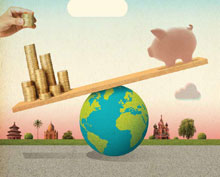Seizing the Moment
Good economic times offer an opportunity to tackle budget deficits

The global economy has a spring in its step. Growth is picking up, and the IMF has been ratcheting up its forecasts. Government coffers are filling and, with more people at work, demand for public social support is receding. The fiscal woes of the past decade seem behind us.
But this sunny perspective ignores debt levels that remain close to historic highs and the inevitable end of the cyclical upswing. Estimates of underlying growth potential have hardly budged, and interest rates—the cost of servicing all this debt—are starting to rise, making it harder to refinance bonds and loans.
How the government taxes, spends, and manages debt is therefore as hot a political topic as ever. Just look at recent debates in the US Congress and the German coalition talks. While fiscal choices are a matter of politics, recent research and experience can teach us much about the best path forward.
Start with the question of how much debt is too much. Academics and policymakers agree that a general limit—such as the 60 percent of GDP in the EU Maastricht Treaty—no longer makes sense; it doesn’t capture enduringly low interest rates and nominal growth or countries’ complex circumstances or credibility with financial markets. Japan clearly can carry more debt load than, say, Egypt. But few deny the urgency of debt that is high and rising.
Low-income economies may be at greatest risk. Traditionally, they borrowed from official creditors at below-market rates. But in recent years, many took advantage of rock-bottom interest rates to load up on commercial debt, leaving them vulnerable to financial market swings. Higher global rates could divert precious budget resources to debt servicing from crucial infrastructure projects and social services. So it is all the more important for these countries to strengthen their tax capacity.
The recent postcrisis experience also holds lessons on when to tackle debt—and when not to. Spending cuts and tax hikes during a recession may only amplify the decline. It is much less painful to revamp the tax and benefit system when the economy is on an upswing and as part of a multiyear adjustment. Research shows that the stimulatory effect of fiscal expansion is weak when the economy is close to capacity. So increasing budget deficits now would be counterproductive in most countries. Conversely, raising budget balances toward their medium-term targets can be achieved at little cost to economic activity.
How best to reduce deficits? To raise revenue, simplify the tax code, broaden the tax base, and improve collection capacity. On the spending side, cutting unproductive current expenses (for instance, on an inefficient civil service) and subsidies (for instance, on energy consumption) is the way to go. Growth-enhancing infrastructure investments and crucial social services such as health and education should be maintained. Well-designed fiscal policy can address inequality and stimulate growth.
The time to fix the fiscal roof is now, while the sun is shining. Policymakers should heed the lessons learned and tackle debt on the upswing.
Opinions expressed in articles and other materials are those of the authors; they do not necessarily reflect IMF policy.








